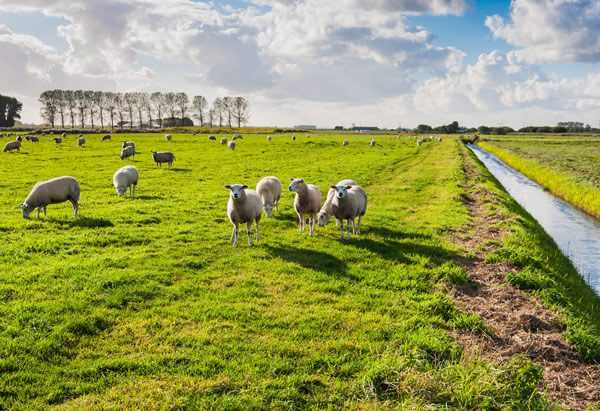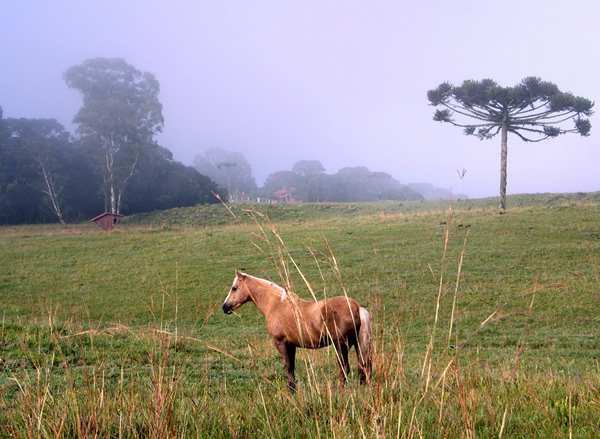 |
| Rangeland |
Open land of a wide variety of types, including grasslands, shrublands, marshes, and meadows as well as some desert and alpine land, is known as rangeland.
Rangeland is a valuable and resilient ecosystem resource that supports considerable plant and animal life. Rangeland generally refers to a kind of land rather than a use of that land.
The Society for Range Management defines rangelands as “land on which the native vegetation (climax or natural potential) is predominantly grasses, grass-like plants, forbs, or shrubs.” Rangeland “includes lands revegetated naturally or artificially”as well as “natural grasslands, savannas, shrublands, most deserts, tundra, alpine communities, coastal marshes and wet meadows.”
  |
Rangelands usually have some limitation for intensive agriculture, such as low and erratic precipitation, lack of soil fertility, shallow or rocky soil, or steep slopes. In addition to livestock grazing, rangelands serve multiple-use functions such as providing recreational opportunities, watersheds, mining locations, and habitat formany animal species.
Renewable natural resources associated with rangelands are plants and animals (and, in some senses, water). Nonrenewable resources include minerals and other extractable materials.
Location and Characteristics Rangelands are extensive and extremely variable. As defined by the Society for Range Management, they occupy more than 50 percent of the world’s total land surface and about 1 billion acres in the United States alone. Rangelands are home to nomadic herders on nearly every continent.
They vary from high-elevation alpine tundra and highlatitude Arctic tundra to tropical grasslands. The tall-grass prairies in the United States (now mostly plowed for intensive agriculture) and the rich grasslands of eastern Africa are among the most productive.
 |
| pastureland |
Rangelands grade into woodlands and forests as woody species and trees become more abundant. Some forests are grazed by wild and domestic animals, and the distinction between rangeland and forest is often not clear.
The other difficult distinction is between rangeland and pastureland. Pastureland is generally improved by seeding, fertilization, or irrigation, whereas rangelands support native plants and have little intensive improvement.
In the United States, rangeland improvements during the twenty years following World War II often included brush control, grazing management, and seeding, but rangelands were not irrigated. After the 1970’s, when fuel costs increased and environmental concerns about pesticide use increased, brush control practices were reduced considerably.
Today environmental concerns include rangeland degradation from overgrazing, especially on riparian vegetation along streams, and concern for endangered animal and plant species. These issues have become controversial in the United States.
Rangelands as Ecosystems
 |
| Rangelands as Ecosystems |
Rangelands constitute natural ecosystems with nonliving environmental factors such as soil and climatic factors. Life-forms are primary producers (grasses, forbs, and shrubs), herbivores (livestock; big game animals such as deer and bison; and many rodents and insects), carnivores (such as coyotes, bears, and eagles), and decomposers (fungi and bacteria) that break down organic matter into elements that can be utilized by plants. Plants convert carbon dioxide and water into complex carbohydrates, fats, and proteins that nourish animals feeding on the plants.
Individual chemical elements are circulated throughout the various components.Many of these elements are present in the soil, including phosphorus, magnesium, potassium, and sulfur.
Nitrogen, on the other hand, is present in large amounts in the atmosphere but must be converted (fixed) into forms that can be utilized by plants before it can be cycled. Energy is fixed through the process of photosynthesis and transformed to forms useful for the plants, then the animals that feed on plants.
When chemicals are taken up by plant roots from the soil, they become available to a wide group of herbivores, from small microbes to large ungulates. Eventually nutrients are passed on to organisms at higher trophic levels (omnivores and carnivores).
   |
Both plant and animal litter is eventually broken down by decomposers—bacteria, fungi, and other soil organisms—and returned to the soil or, in the case of carbon or nitrogen, given off to the atmosphere.
However, energy is degraded at each step along the way; energy is transferred but not cycled. Grazing animals on rangelands influence plants by removing living tissue, by trampling, and by altering competitive relations with other plants. Large grazing animals tend to compact the soil, reducing infiltration and increasing surface runoff.
Rangeland Dynamics
Rangelands vary considerably with time. Scientists are gaining a better understanding of some factors related to rangeland change.
Pollen records and, in the southwestern United States, packrat middens have been used to reconstruct past climate and vegetational conditions. Some areas have become drier and others more mesic. The formation and retreat of glaciers influenced climatic patterns and soil development.
 |
| Rangeland Dynamics |
A recent general trend in many rangelands is an increase in woody plants at the expense of grasses. Many factors are probably responsible for these shifts, but fire control, overgrazing, climatic shifts, introduction of exotic species, and influence of native animals are likely causal agents.
Rangelands are being threatened by encroachment from crop agriculture as worldwide development increases. Nomadic herders traditionally met periodic drought conditions by having the flexibility to move to areas not impacted by drought.
Now, with area lost to livestock grazing and other political restrictions, herders are often forced to maintain higher livestock numbers to support those directly dependent on livestock. Despite various kinds of disturbances and stresses on rangelands, these areas have supported many large grazing animals and people for centuries.